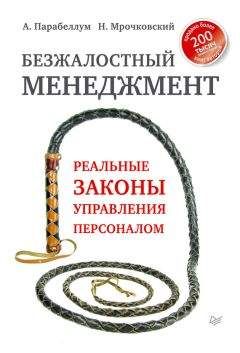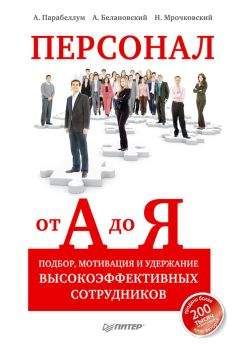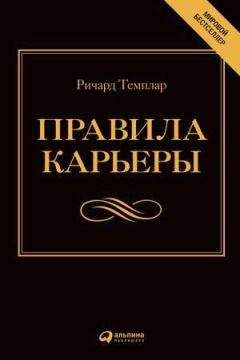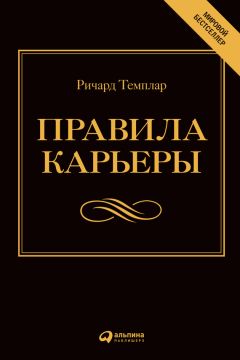Уильям Паундстоун - Найти умного. Как проверить логическое мышление и творческие способности кандидата
На всех четырех сайтах вы найдете головоломки и задачи. Сайты Бондалапати и Селлса специально ориентированы на Microsoft (хотя большинство из приведенных вопросов задаются и в других компаниях) и приводят также вопросы по программированию. На сайте Прайора приводятся ответы – на других сайтах их или вообще нет, или приводится всего несколько ответов. Другие сайты, на которых также есть несколько вопросов:
«How to Hack the Microsoft Interview,» 1997 http://www.howdyneighbor.com/zephyr (вопросы только по программированию);
«Microsoft Interview Questions» http://www.4guysfromrolla.com/misc/100798-1.shtml;
«Microsoft Interview Questions,» 2001 http://www.acetheinterview.com/qanda/Microsoft_interview.html (небольшой список вопросов Microsoft, который собрал Andrew Smith. См. также раздел «Analytical» (аналитический), в котором приводится еще несколько вопросов Microsoft с ответами на них читателей как правильными, так и неправильными).
Библиография
Adler, Robert S. and Ellen R. Pierce. Encouraging Employers to Abandon Their «No Comment» Policies Regarding References: A Reform Proposal. Washington and Lee Law Review 53, no. 4 (1996): 1,381+.
Auletta, Ken. World War 3.0: Microsoft and Its Enemies. New York: Random House, 2002.
Ball, W. W. Rouse, and H. S. M. Coxeter. Mathematical Recreations and Essay. 1892. Reprint, New York: Dover, 1997.
Bank, David. Breaking Windows: How Bill Gates Fumbled the Future of Microsoft. New York: Free Press, 2001.
Barr, Adam David. Proudly Serving My Corporate Masters: What I Learned in Ten Years as a Microsoft Programmer. Lincoln, Nebr.: illniverse.com, 2000.
Block, N. J., and Gerald Dworkin. The IQ Controversy. New York: Pantheon, 1976.
Bruner, J. S., and Leo Postman. On the Perception of Incongruity: A Paradigm. Journal of Personality XVIII (1949): 206–23.
Christensen, Clayton M. The Innovator’s Dilemma. Rev. ed. New York: HarperCollins, 2000.
Corcoran, Elizabeth, and John Schwartz. The House That Bill Gates’s Money Built. Washington Post, August 28, 1997. A01
Crack, Timothy Falcon. Heard on the Street: Quantitative Questions from Wall Street Job Interviews. N.p.: Timothy Falcon Crack, 2001. (Available from Web booksellers or by contacting author at [email protected])
Dolev, Danny, Joseph Halpern, and Yoram Moses. Cheating Husbands and Other Stories. Distributed Computingl, no. 3 (1986): 167–76.
Dudeney, Henry Ernest. Amusements in Mathematics, 1917. Reprint, New York: Dover, 1970.
Frase-Blunt, Martha. Games Interviewers Play. HR Magazine, January 2001.
Freedman, David H. Corps Values. Inc Magazine, April 1, 1998.
Gamow, George, and Marvin Stern. Puzzle-Math. New York: Viking, 1958.
Gardner, Martin. The Ambidextrous Universe: Left, Right, and the Fall of Parity. New York: New American Library, 1969. Mathematical Puzzles and Diversions. New York: Simon and Schuster, 1959. Penrose Tiles to Trapdoor Ciphers. New York: W. H. Freeman, 1989. Wheels, Life and Other Mathematical Amusements. New York: W. H. Freeman, 1983.
Gates, Bill. Business @ the Speed of Thought. New York: Warner Books, 1999.
Gates, Bill, Nathan Myrhvold, and Peter M. Rinearson. The Road Ahead. Rev. ed. New York: Penguin, 1996.
Gimein, Mark. Smart Is Not Enough. Fortune, January 8, 2001.
Gladwell, Malcolm. The New-Boy Network. The New Yorker, May 29, 2000, 68–86.
Gleick, James. Making Microsoft Safe for Capitalism. New York Times Magazine, November 5, 1995.
Gould, Stephen Jay. The Mismeasure of Man. Rev. ed. New York: W. W. Norton, 1996.
Hiltzik, Michael A. The Twisted Legacy of William Shockley. Los Angeles Times Magazine, December 2, 2001.
Isaacson, Walter. In Search of the Real Bill Gates. Time, January 13, 1997, 45–57.
Johnson-Laird, Philip N. Human and Machine Thinking. Hillsdale, N.J.: Lawrence Erlbaum, 1993.
Kane, Kate. The Riddle of Job Interviews. Fast Company, November 1995, 50+.
Kim, Eugene Eric. TRIZ: The Theory of Inventive Problem Solving. Dr. Dobb’s Journal, May 17, 1999.
Kordemsky, Boris A. The Moscow Puzzles. Перевод Albert Parry, редакция Martin Gardner, адаптировано из русской книги издания 1956 года, название которой можно перевести как Mathematical Know-How. New York: Dover, 1992.
Kuhn, Thomas. The Structure of Scientific Revolutions. Chicago: University of Chicago Press, 1962.
Langley, Pat, Herbert Simon, Gary Bradshaw, and Jan Zytkow. Scientific Discovery: Computational Explorations of the Creative Process. Cambridge, Mass.: MIT Press, 1987.
Leslie, Mitchell. The Vexing Legacy of Lewis Terman. Stanford Magazine, July/August 2000 <http://www.stanfordalumni.org/ news/magazine/2000/julaug/articles/terman.html>.
Lewis, Michael. Liar’s Poker: Rising Through the Wreckage of Wall Street. New York: Penguin, 1990.
Lieber, Ron. Wired for Hiring: Microsoft’s Slick Recruiting Machine. Fortune, February 1996.
Loyd, Sam. Mathematical Puzzles of Sam Loyd. New York: Dover, 1959.
McCarty, Ellen. It’s Not a Job Interview, It’s a Subculture! Fast Company, August 2000, 46.
McKenna, Gene. An Interview with Microsoft, 2001 <http://www.meangene.com/ essays/Microsoft_interview.html>.
Microsoft Corporation. Inside Out: Microsoft – In Our Own Words. New York: Warner Books, 2000.
The Micro$oft Hate Page <http://www.enemy.org>.
Mongan, John, and Noah Suojanen. Programming Interviews Exposed: Secrets to Landing Your Next Job. New York John Wiley, 2000.
Munk, Nina, and Suzanne Oliver. Think Fast! Forbes, March 24, 1997, 146–51.
Newell, Alan, and Herbert Simon. Human Problem Solving. Engle-wood Cliffs, N.J.: Prentice Hall, 1972.
Paulos, John Allen. Once upon a Number: The Hidden Mathematical Logic of Stories. New York: Basic Books, 1998.
Perkins, David. Archimedes’ Bathtub: The Art and Logic of Breakthrough Thinking. New York: W. W. Norton, 2000.
Perry, Phillip M. Cut Your Law Practice’s Risks When Giving References for Former Support Staff. Law Practice Management, September 1994, 54.
Shafir, Eldar. Uncertainty and the Difficulty of Thinking Through Disjunctions. In COGNITION on Cognition, edited by Jacques Mehler and Susana Franck. Cambridge, Mass.: MIT Press, 1995.
Shafir, Eldar, and A. Tversky. Thinking Through Uncertainty: Nonconsequential Reasoning and Choice. Cognitive Psychology 24 (1992): 449–74.
Shurkin, Joel. Broken Genius: A Biography of William B. Shockley. Work in progress.
Smith, Rebecca. The Unofficial Guide to Getting a Job at Microsoft. New York: McGraw-Hill, 2000.
Spearman, Charles. General Intelligence Objectively Determined and Measured. American Journal of Psychology 15 (1904): 201–93.
Spolsky, Joel. The Guerrilla Guide to Hiring» 2000 <http://www.joelonsoftware.com/ articles/fog0000000073.html>.
Sternberg, Robert, and Janet E. Davidson, eds. The Nature of Insight. Cambridge, Mass.: MIT Press, 1995.
Tashian, Carl. The Microsoft Interview, 2001 <http://www.tashian. com/Microsoft.html>.
Terman, Lewis M. The Measurement of Intelligence. London: Har-rap, 1919.
Tversky, Amos, and Eldar Shafir. The Disjunction Effect in Choice Under Uncertainty. Psychological Science 3 (1992): 305–9.
Van Mechelen, Rod. Sex, Power and Office Politics at Microsoft <http://www.nwlink.com/~rodvan/msft.html> (уже не существует).
Weinstein, Bob. Landing a Job at Microsoft: One Techie’s Story of Interviewing for the Software Giant, 2001 <http://home.techies.com/Common/Content/ 2000/11/2career_landingjobMicrosoft.html>.
Об авторе
Уильям Паундстоун – автор девяти книг, включая серию-бестселлер «Большие загадки» (Big Secrets) и «Карл Саган: Жизнь в космосе» (Carl Sagan A Life in the Cosmos). Он также публиковался в журналах The Economist, Esquire, Harper’s и New York Times Book Review. Его работы два раза номинировались на Пулитцеровскую премию. Живет в Лос-Анджелесе.
Сноски
1
IQ – это аббревиатура от англ. Intelligence Quotient – коэффициент интеллектуальности. – Здесь и далее прим. пер.
2
Френологи – последователи лженауки, утверждавшей, что по выпуклостям («шишкам») на черепе человека можно судить о его личностных качествах и способностях.
3
Мадам Лафардж – персонаж романа Чарльза Диккенса «Повесть о двух городах», женщина, писавшая доносы на своих соседей.
4
Кандидатов на вступление в такие братства (fraternities), существующие во многих американских университетах, заставляют выполнять бессмысленные, неприятные и болезненные задания, например лечь в гроб, который затем закрывают крышкой, выдерживать побои и т. п.




